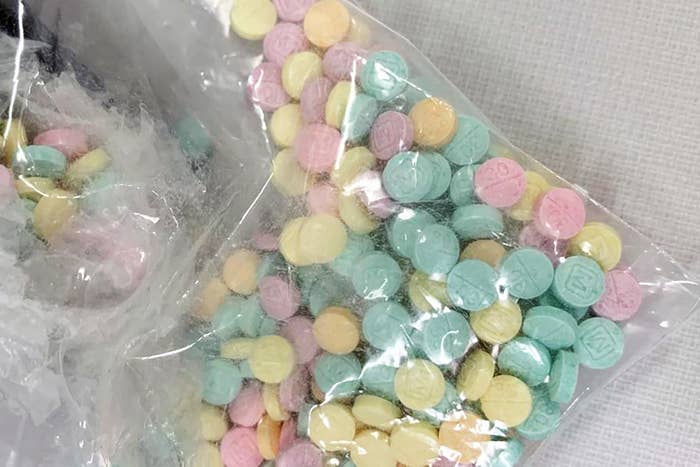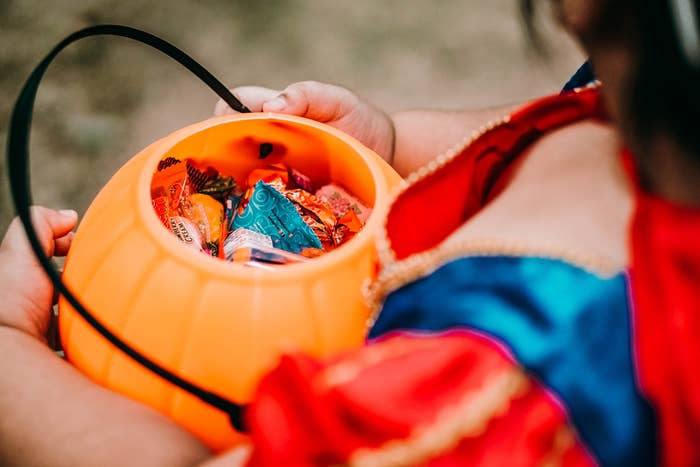
Nothing says Halloween like carved pumpkins, haunted houses, and unsubstantiated warnings about dangerous candy.
It happens every year, and every year we (fortunately) fail to hear about trick-or-treaters who died or got seriously injured after consuming candy stuffed with sewing needles or sprinkled with cocaine.
This time around, the focus is on rainbow fentanyl, a synthetic opioid widely used for pain management, which is illegally made into brightly colored pills that can resemble candies like SweeTarts. The US Drug Enforcement Administration has said it’s “a deliberate effort by drug traffickers to drive addiction amongst kids and young adults.”
Federal health officials consider fentanyl, which is up to 50 times stronger than heroin and 100 times stronger than morphine, to be the nation’s deadliest drug threat. Just 2 milligrams — an amount small enough to fit on the tip of a pencil — can be lethal. And because fentanyl is commonly mixed with other drugs, like heroin, cocaine, and methamphetamine, its risks are largely unpredictable — and responsible for huge numbers of accidental overdoses each year.
From 2019 to 2020, the overdose death rate involving fentanyl and similar synthetic opioids increased by more than 56% in the US, the CDC says. More than 57,000 people died in 2020 after exposure to the drug, more than 18 times as many as in 2013. In 2021, that number was more than 71,000. It’s played a role in the high-profile deaths of celebrities, including Mac Miller, Prince, Tom Petty, and Michael K. Williams.
In August, the DEA said it had seized rainbow fentanyl pills, powder, and blocks “that resemble sidewalk chalk” in 26 states. On Oct. 4, the agency said it had seized about 15,000 colored pills hidden in a Lego box destined for distribution in New York City.
Shortly after these reports went public, chaos ensued. Hospital systems, state health departments, school districts, and politicians, including Sen. Chuck Schumer and a group of Senate Republicans (who blame President Joe Biden’s “open border policies”) issued their own warnings about how drug cartels are targeting vulnerable children with rainbow fentanyl, all just in time for Halloween. On Fox News, a panel discussed whether parents should abandon trick-or-treating this year altogether.
But drug and addiction experts who spoke to BuzzFeed News aren’t convinced this is (or ever has been) a legitimate concern.
“There’s no evidence that this is happening, and no one’s giving away free drugs, especially in Halloween candy,” said Dr. Ryan Marino, an emergency physician and addiction medicine specialist at University Hospitals Cleveland Medical Center. “I think getting more information is the best way to empower people to be safe, but at the same time a lot of this reporting from the DEA is not accurate and is distracting from the real things that need to be talked about.”
Overall, our discussions about fentanyl and the opioid crisis need to change.
“The weird fixation on drug dealers out to get your kids just really distracts everybody and makes people more resistant to believing in doing what we can to help people be safe,” Marino said, adding that society’s view of drug use “as some sort of moral issue” is really holding us back.
“If we try to be objective about it, we could really save a lot of lives,” he said.
Why rainbow fentanyl isn’t specifically a kid (or Halloween) problem

It’s true that fentanyl use has been increasing among teens. A study published in June in the American Journal of Drug and Alcohol Abuse analyzed National Poison Control data for 2015 and 2021 and found that reported fentanyl exposures increased among all age groups ages 13–39, but the largest jump was among 13- to 19-year-olds.
And news during summer 2022 only added fuel to that fire. There were more than a dozen reports of teens overdosing after taking pills suspected to be laced with fentanyl, including at least four deaths, in a matter of weeks across the US, including in California and Texas.
But colored pills have been circulating on the black market for years, so nothing about rainbow fentanyl strikes experts as odd or a tactic to lure in curious children.
Marino said the DEA’s declaration that drug dealers are targeting kids was “very bizarre,” given it provided no evidence to prove that intention.
The DEA did not respond to BuzzFeed News’ request for comment.
Fentanyl has taken the form of blue pills for a while now, sporting an imprinted “M” to mimic oxycodone pills — prescription opioids for pain relief. They’re now coming in a wider variety of colors that experts admit can look like candy, yet not for the reasons government officials are advertising. (The DEA said there’s no evidence certain colors are more potent than others.)
“I, personally, don’t think they’re being marketed to kids, but I think making them look like candy makes them easier to smuggle or hide,” Joseph Palamar, an associate professor in the department of population health at NYU Langone Health, told BuzzFeed News in an email.
Two men were charged in September with trafficking thousands of fentanyl pills into Connecticut that were stuffed inside Nerds candy boxes and Skittles bags, although it’s unclear whether those pills were colored.
In the unlikely event someone throws a bunch of loose colored pills in a child’s Halloween candy bag, the odds are low that a parent would fail to notice them, Marino said. The pills would likely be thrown away before a kid puts them in their mouth, he said.
“I’m assuming the pills aren’t sweet,” said Palamar, whose research focuses on drug use in the US. “I hope if a kid does put one in his mouth, he’ll just spit it out.”
Disguising fentanyl in candy likely isn’t the best way to target the children and young adults who are actually interested in trying and buying drugs, said Jonathan Caulkins, a professor and expert in opioid and substance abuse policy at Carnegie Mellon University.
“I’m not sure that the youth who are using illegal pills are in the same age bracket that would say, ‘Oh, this is a fruit tart’ kind of thing,” Caulkins said.
Meanwhile, telling kids they can’t go trick-or-treating this year is “not going to help anybody,” Marino said.
“That’s so clearly distracting from what parents need to talk to their kids about,” he said. “Kids go out and drink alcohol. Kids try anything, so if we’re just trying to lock them up at home, we’re not giving them any tools to be safe from anything, and that doesn’t just mean fentanyl.”
Why fentanyl use is increasing
Fentanyl is used as a therapeutic agent because it grabs onto opioid receptors in the parts of the brain that control pain and emotions, triggering feelings of relaxation, pleasure, and relief. Because it’s a powerful pain medication, it’s typically given to people with nerve damage, cancer, chronic pain, and severe injuries, or during or after surgery.
Stronger than other opioid medications, fentanyl is often prescribed via a slow-release patch. However, these have been linked to overdose deaths when abused, diverted, or accidentally ingested by children.
One of the main reasons fentanyl overdoses are on the rise in the US is that drug dealers have realized how much more bang for their buck they get by mixing it with other, more expensive drugs, Caulkins said.
Fentanyl not only costs less per kilogram but also has more “pain equivalent doses” per kilogram than other drugs, so over time dealers add more and more of it into the mix until the entire “hot bag,” as Caulkins calls it, is made mostly of fentanyl. Eventually, regular users of these contaminated drugs develop a greater tolerance to opioids and thus a stronger dependence on them. Not to mention drug producers are increasing fentanyl’s potency to further reduce costs.
Fake prescription pills that contain fentanyl are frequently made to look like Adderall, Xanax, Percocet, or Vicodin. They are incredibly easy to buy via social media and other online channels, which makes children especially vulnerable to overdose if they think they are taking a drug they know, like Adderall. Such accessibility also contributes to the drug’s geographic spread, Caulkins said.
In general, Marino feels the recent uptick in fentanyl use in the US “is probably in direct relation to our drug policies,” namely a concept called the “Iron Law of Prohibition.” Richard Cowan, a cannabis activist, coined the term in a 1986 National Review article titled “How the Narcs Created Crack” in which he argued that strict law enforcement against drugs actually creates incentives for the illegal sale of stronger drugs.
“When you take away all of the heroin in the world and don’t do anything to address the demand for heroin,” Marino said, “then you’re left with a market that drives people to create something new — and fentanyl is very easy to make.”
Marino and many others believe this contributed to the fentanyl crisis and the recent circulation of more potent opioids like nitazenes. Originally developed for pain relief in the 1960s but never approved for clinical use in the US, nitazenes have been found in several regions in recent years — including Tennessee, where four times as many nitazene-involved overdoses occurred in 2021 as in 2020.
Unfortunately, we’re so deep into the opioid crisis that experts like Caulkins think there’s no going back. “The scale of how terrible this is is almost hard to wrap your head around,” he said. “I am not optimistic that the toothpaste can get put back in the tube this time, but I don’t begrudge law enforcement for trying.”
You can test some illicit drugs for fentanyl, but there are limitations
Lab testing has revealed that 4 out of every 10 fake pills containing fentanyl have a “potentially lethal dose,” according to the DEA, and it’s impossible to tell by looking whether a drug is laced with fentanyl — and, if so, how much. This means it’s important to know what an overdose looks like. Signs can include small pupils, loss of consciousness, choking or gurgling sounds, clammy or discolored skin, and weak breathing.
Anyone can experience a fentanyl overdose, but “opioid naive” people who are using the drug unintentionally, such as those who sniff cocaine once at a bar or pop a pill while clubbing, may face greater risks of serious outcomes, Palamar said.
One of the best ways to prevent a fatal overdose, aside from carrying the overdose reversal medicine naloxone (Narcan), is to try to keep others around you when using fentanyl, Marino said. (If you want to have naloxone on hand, you can buy it as a nasal spray at the pharmacy counter without a prescription.)
Test strips — small pieces of paper that can detect the presence of fentanyl in drugs like cocaine, heroin, and methamphetamine — can only give you a yes or no answer and can’t tell you how much fentanyl is present. And these days, you can assume most street drugs contain some fentanyl.
Still, because it could mean life or death, experts recommend testing drugs anyway. This generally requires crushing some of the pills and/or dissolving the drugs in water. (The CDC offers instructions for how to use fentanyl strips.)
The reality is that people with an opioid use disorder may not take the time to test once their cravings or withdrawal symptoms kick in, Caulkins said.
“It can help if somebody is purchasing from a new supplier for the first time and for whatever reason they’re suspicious,” Caulkins said, “but I’m not optimistic test strips are a game-changer kind of thing.”
Palamar agrees that test strips have some limitations, mostly that they “can lead to a false sense of security” because they can only detect a handful of fentanyl analogs (drugs with similar chemical structures to fentanyl, like the more potent carfentanil).
Plus, fentanyl may be more highly concentrated in some pills or areas in a batch of drugs, so testing just a portion might miss it.
We’re going about the fentanyl problem all wrong
A lot of work has been put into developing medications like buprenorphine, methadone, and naltrexone that help reduce cravings and withdrawal symptoms in those with opioid addictions. There’s also cognitive behavioral therapy, supervised consumption sites where people can use drugs in a safe and monitored area, and, of course, naloxone, which can immediately treat an overdose.
They’re all powerful tools, experts say, but they don’t solve the underlying problem, which is preventing opioid addiction from the start.
Studies show that more than two-thirds of people with substance use disorders relapse after beginning treatment. Part of the solution, Caulkins said, is to be even more cautious than we already are about prescribing opioids for pain management to prevent more people from developing substance use disorders. And like safe gun practices, people need to ensure their medications are safely stored so children can’t get a hold of them.
Teens in particular should know that pills sold illegally online or elsewhere that look pharmaceutical grade can contain fentanyl — just because they look real doesn’t mean they are, Palamar said. After all, kids will try drugs if they want to so it’s important they have accurate information.
“Given that I was young once myself, I recall not believing messages that seemed exaggerated, so I think parents, teachers, and media organizations need to do a better job at teaching kids about the true dangers of fentanyl and about drugs in general,” Palamar said. “But then again, parents and teachers need more education themselves.”
Marino feels the current messaging to kids is based on fear and the assumption that teaching young people how to use drugs safely encourages them to use drugs.
Instead, he said, communicating the risks of buying drugs on the black market, teaching young people how to use test strips and naloxone, and informing them of overdose signs to look for will encourage them to be more honest about their drug use or exposures.
